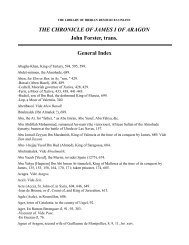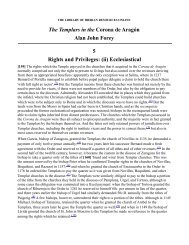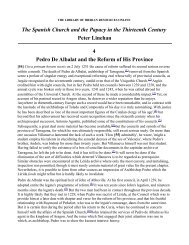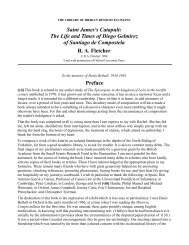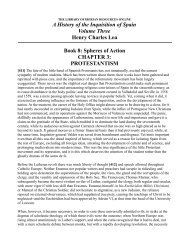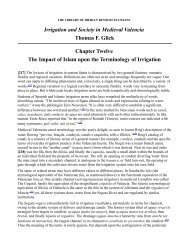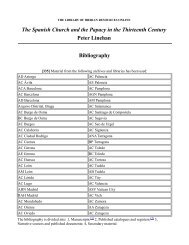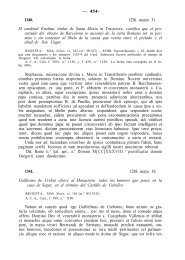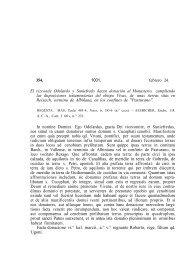Chapter 6 - The Library of Iberian Resources Online
Chapter 6 - The Library of Iberian Resources Online
Chapter 6 - The Library of Iberian Resources Online
You also want an ePaper? Increase the reach of your titles
YUMPU automatically turns print PDFs into web optimized ePapers that Google loves.
THE LIBRARY OF IBERIAN RESOURCES ONLINE<br />
Crime and Society in Early Modern Seville<br />
Mary Elizabeth Perry<br />
6<br />
Holy Men and Rascals<br />
[116] Pedro Fernandez de Esquibel, a clergyman in Seville, was arrested by secular authorities in 1581<br />
for forging royal decrees. <strong>The</strong> magistrates, unwilling to release to the ecclesiastical courts a man<br />
accused <strong>of</strong> such a serious crime, consulted with Church leaders. <strong>The</strong> Church agreed to defrock him<br />
immediately so that he could remain in secular custody before hanging in the Plaza de San Francisco.<br />
Here is an example <strong>of</strong> the partnership between the Church and political authority, and clear evidence <strong>of</strong><br />
the bonds between Church and crime. (1)<br />
<strong>The</strong> Church in Seville had ties with both political authority and the underworld because the clergy<br />
included a variety <strong>of</strong> people from different classes. <strong>The</strong> poorest assistant to a parish priest belonged to<br />
the secular clergy, and so did the wealthy and notable <strong>of</strong>ficers <strong>of</strong> the Cathedral. <strong>The</strong> regular clergy,<br />
those who had accepted the regulation <strong>of</strong> a religious order, were various enough to include cloistered<br />
nuns from noble families and monks who wandered the countryside begging for bread. Some priests<br />
had experienced hunger and deprivation, and they blamed this injustice on the social order. A few<br />
sought redress through social action as well as prayer. One priest even became a popular leader in the<br />
Revolt <strong>of</strong> the Pendon Verde in 1652. (2) On the other hand, some were very unpopular, hated for their<br />
educated speech and their presumption that ordinary men could not deal with God without their<br />
intercession.<br />
[117] Church relations with political authority and the underworld were further complicated because<br />
the Church was far more than a religious institution. During the early modern period the Church and<br />
the religious orders owned significant amounts <strong>of</strong> land. Some religious orders were producers; others<br />
invested in commerce. As creditors, they and the Church invested in government bonds (juros),<br />
mortgages on land (censos), and simple loans. In addition, the Church, as a political force, shaped<br />
legislation, bolstered the legitimacy <strong>of</strong> secular governments, and furnished men to act as ministers and<br />
diplomats. A social institution, the parish church was a focus for each neighborhood in the city. <strong>The</strong><br />
Church was the major agency for education and charity. It sponsored most <strong>of</strong> the processions and<br />
fiestas <strong>of</strong> Seville, and it preserved the legends that helped to unify this diverse city.<br />
Underworld people distinguished this complex institution, the Church, from religion, but other city<br />
residents believed that the two were symbolically fused. Most people <strong>of</strong> Seville looked on the Church<br />
and underworld as symbols <strong>of</strong> the holy and pr<strong>of</strong>ane. More than opposites, the Church and underworld<br />
met in a curious confusion <strong>of</strong> antagonism and mutual exploitation. <strong>The</strong>ir relationship is best<br />
demonstrated in three major roles that the Church played in early modern Seville: as intermediary,<br />
refuge, and caricature.<br />
THE CHURCH AS INTERMEDIARY<br />
In early modern Seville people usually looked to the Church as intermediary between them and God.<br />
From the pulpit they learned what God's laws were. In the confessional they learned how God expected
them to translate His laws into everyday behavior. When they wanted to ask something <strong>of</strong> God, the<br />
traditional prayers and rituals <strong>of</strong> the Church helped them to present their petitions in the proper form<br />
and language. Latin, the language <strong>of</strong> the priest before the altar, was <strong>of</strong> course unintelligible to most<br />
people in the congregation, but they believed that the priest could use it to speak to God for them.<br />
People <strong>of</strong>ten turned to the Church to explain disasters and to advise them what to do. A religious<br />
procession led by an image [118] <strong>of</strong> our Lady <strong>of</strong> the Water in 1605 helped the people <strong>of</strong> Seville feel<br />
less impotent in time <strong>of</strong> drought. Later in that century, Church authorities explained an epidemic as<br />
divine punishment for loose morals, and they urged the city to prohibit all drama and comedies in order<br />
to avoid another plague. (3) <strong>The</strong>se intermediaries <strong>of</strong>fered the security <strong>of</strong> clear-cut answers in uncertain<br />
times. <strong>The</strong>y promoted unity by <strong>of</strong>fering a single interpretation <strong>of</strong> the causes <strong>of</strong> all ills and the best<br />
remedies for them. A community that looked to a priestly intercessor did not fall apart so readily into<br />
quarreling factions.<br />
Underworld people awaiting execution in the city's prisons <strong>of</strong>ten turned from past cynicism and<br />
sinfulness to the monks and priests who could act as intermediaries. Pedro de León, the Jesuit chaplain<br />
<strong>of</strong> the Royal Prison in Seville between 1578 and 1616, described the prisoners' warm reception <strong>of</strong> his<br />
sermons and prayers. Many would kiss his hand and tell him with tears in their eyes how much his<br />
words meant to them. (4) <strong>The</strong>re is no doubt that some lifelong thugs repented at the end and were<br />
sincerely grateful for the priests who walked and prayed with them and helped them to mount the steps<br />
to the scaffold, strengthened in spite <strong>of</strong> their quaking knees.<br />
Not all condemned prisoners looked to the Church as intermediary. Pedro de Leon wrote that it was<br />
very difficult to pierce the tough exterior <strong>of</strong> some prisoners, and another firsthand account <strong>of</strong> the Royal<br />
Prison <strong>of</strong> Seville describes how the prisoners would mock priests, playing at saying Mass or<br />
performing as dramatic penitents. At night they would call for the penitential brotherhood <strong>of</strong> the prison,<br />
not out <strong>of</strong> devotion but for the [119] horrifying delight <strong>of</strong> watching them punish themselves. (5) To<br />
these people the concept <strong>of</strong> the Church as intermediary was a joke.<br />
One reason for underworld cynicism was that the Church also acted as intermediary between them and<br />
the secular law. People <strong>of</strong> the underworld clearly recognized the close alliance between the institutional<br />
Church and political authority. Prisoners <strong>of</strong>ten tried to exploit this alliance, confessing to the prison<br />
chaplain in such a way that the priest would be moved to intervene on their behalf and get a last-minute<br />
reprieve. On the other hand, secular authorities tried to persuade priests to force prisoners to confess to<br />
crimes so that they could use their confessions as evidence against them. <strong>The</strong>y sometimes condemned a<br />
prisoner to death without sufficient pro<strong>of</strong> <strong>of</strong> his guilt, refused his appeals, and then assigned a confessor<br />
who would insist that the prisoner must confess to the crimes in order to "die a good Christian." (6)<br />
Priests who helped condemned men go to their death as "good Christians" undoubtedly provided<br />
comfort for many, but they also helped to sanctify this ritualized act <strong>of</strong> violence by secular justice<br />
against those accused <strong>of</strong> breaking its laws. One view <strong>of</strong> the priest with a condemned man at the gallows<br />
is that he was returning a stray sheep to the flock; another view is that he was mesmerizing the sheep,<br />
so that the creature would accept its fate as a sacrificial victim.<br />
Churchmen frequently used underworld people to personify evil to the people <strong>of</strong> Seville. <strong>The</strong> preacher<br />
who thundered against immorality in the city warned <strong>of</strong> sins committed by the "gente de mal vivir"<br />
(bad people), the "rufianes" (thugs), and the "mujeres perdidas" (prostitutes). Because city residents<br />
saw these underworld people on their own streets, they could understand the priests' admonitions.<br />
<strong>The</strong> secular government <strong>of</strong> Seville could use morality as a pillar <strong>of</strong> its legitimacy, but it lacked enough<br />
sheriffs and judges [120] to enforce its moral legislation without Church assistance. <strong>The</strong> parish priest<br />
railed against immorality from his pulpit, and he used the confessional to hear individual cases <strong>of</strong>
immorality. <strong>The</strong> more formal courts <strong>of</strong> the Inquisition punished moral <strong>of</strong>fenders as well as heretics. <strong>The</strong><br />
Church was an open partner in upholding the moral order <strong>of</strong> the city oligarchy, and to many underworld<br />
cynics this partisanship belied its posture as disinterested intermediary.<br />
Another reason for cynicism about the Church as intermediary was that some churchmen were more<br />
concerned with financial affairs than with matters <strong>of</strong> the spirit. <strong>The</strong> Archbishopric <strong>of</strong> Seville owned<br />
much <strong>of</strong> the land within the city walls, as well as large portions in the surrounding areas. Many<br />
religious groups administered extensive estates. In 1582 the Archbishop <strong>of</strong> Seville censured one <strong>of</strong> his<br />
bishops because he had virtually converted his residence into a manufacturing center and store. A great<br />
scandal erupted in 1642 when it was discovered that an administrator <strong>of</strong> the Jesuit School <strong>of</strong> San<br />
Hermenegildo in Seville had used the funds <strong>of</strong> his order for business speculations, buying and selling<br />
cargoes in the Indies and enriching many <strong>of</strong> his relatives while amassing a debt <strong>of</strong> 90,000 ducats<br />
against the Jesuits. (7)<br />
Ecclesiastical privileges benefited many churchmen in commercial enterprises, and it also provided<br />
many opportunities for the white collar crimes <strong>of</strong> smuggling and counterfeiting. Clerics and Inquisition<br />
<strong>of</strong>ficials were exempt from import duties, and they transported goods and papers without customary<br />
inspection at city gates. Occasionally they were caught smuggling precious metals and merchandise. (8)<br />
<strong>The</strong>oretically outside the jurisdiction <strong>of</strong> secular justice, religious houses could be used for undercover<br />
counterfeiting. In 1639 a clergyman was arrested for counterfeiting the stamped paper that was required<br />
for all legal and [121] commercial transactions in the seventeenth century, and thirteen years later<br />
secular authorities invaded a monastery to arrest some clergymen who were restamping money there.<br />
(9)<br />
Ecclesiastical privilege permitted many people to escape the hand <strong>of</strong> secular justice that lay so heavily<br />
on people <strong>of</strong> the underworld. <strong>The</strong> numbers <strong>of</strong> familiares, lay servants to the Inquisition, increased<br />
dramatically as the Inquisition became more active during this period. Suspected <strong>of</strong> being secret<br />
informers, the familiares were also unpopular because they had the privilege <strong>of</strong> bearing arms and were<br />
exempt from certain prosecutions by secular authorities. <strong>The</strong> confusion resulting from the many new<br />
and unregistered appointments <strong>of</strong> familiares was very useful to those <strong>of</strong> the underworld, who would<br />
sometimes escape the secular law by claiming that they were familiares when they were arrested. (10)<br />
Underworld people could also feel cynical about the Church when churchmen squabbled among<br />
themselves. <strong>The</strong> rivalry between Jesuits and Dominicans <strong>of</strong>ten degenerated into a power struggle<br />
involving the Inquisition, for it had been dominated by the Dominicans since Tomás de Torquemada <strong>of</strong><br />
this order was appointed by Ferdinand and Isabella to head the Inquisition in 1483. Jesuits were<br />
denounced for heresy and for making political sermons. <strong>The</strong>y insisted that they were responsible for<br />
their own members and would punish them for misbehavior, but the Inquisition asserted that these<br />
matters were subject to the Holy Office. In the case <strong>of</strong> Padre Barba, for example, a Jesuit accused <strong>of</strong><br />
having "dishonest relations" with several women, the Society <strong>of</strong> Jesus argued that this was a matter for<br />
internal discipline within the Order, but the Inquisition successfully asserted jurisdiction. (11) <strong>The</strong><br />
Dominican-Jesuit controversy was further complicated because some bishops, opposing the Inquisition<br />
as a [122] rival to their own powerful positions within the Spanish Church, encouraged the Jesuit-<br />
Dominican controversy in order to weaken the Inquisition.<br />
Attempts to correct abuses and reform the clergy increased internal dissension within this group. When<br />
Cardinal Archbishop Rodrigo de Castro tried to reform the clergy in Seville in the last quarter <strong>of</strong> the<br />
sixteenth century, he ran into so much opposition that he asked the Crown to help him get support from<br />
Rome. He succeeded in making several reforms, but at the price <strong>of</strong> much dissension. Reformed monks<br />
attacked the unreformed secular clergy, a form <strong>of</strong> anticlericalism which one scholar has identified in the
picaresque novel Lazarillo de Tormes. (12) In the midst <strong>of</strong> all the accusations and countercharges it is<br />
not surprising that one poor beggar <strong>of</strong> the city, Bartolomé Fuentes, declared that God would not lower<br />
Himself to the hands <strong>of</strong> undignified clergymen. This was too much for the Inquisition, which subjected<br />
him to public penance in an auto de fé on December 22, 1560. (13)<br />
Clerical reform might "purify" the clergy, but it also served political purposes. Both Church and Crown<br />
were concerned with controlling ideology, and the Church was a strong competitor that showed<br />
disturbing tendencies to act independently. Recognizing that clerical reform could curb this competitor,<br />
Philip II readily came to the assistance <strong>of</strong> Cardinal Archbishop de Castro when he needed help<br />
reforming his clergy in Seville. Clerical dissension was a timely excuse for the Crown's imposition <strong>of</strong><br />
restraint on the power, wealth, and independence <strong>of</strong> the Church. To many people clerical reform was<br />
simply an extension <strong>of</strong> central control over more members <strong>of</strong> the clergy, a device to ensure that the<br />
Church would be a tool <strong>of</strong> the secular government.<br />
Cynicism about priests as intermediaries increased in the sixteenth and seventeenth centuries as Seville<br />
became a major center <strong>of</strong> an heretical sect, the Alumbrados. <strong>The</strong>se religious mystics taught that direct<br />
union with God was possible without [123] a priestly intermediary. <strong>The</strong> nuns, monks, and secular<br />
clergy who belonged to the sect acted as spiritual counselors rather than intermediaries. Mysticism was<br />
also an important part <strong>of</strong> the devotional exercises <strong>of</strong> Jesuits and followers <strong>of</strong> Saint Teresa <strong>of</strong> Avila and<br />
Saint John <strong>of</strong> the Cross, but these groups accepted the discipline <strong>of</strong> the Church and did not pose the<br />
serious Alumbrado challenge to priests. Churchmen like Pedro de León tried to distinguish the "false<br />
mysticism" <strong>of</strong> the Alumbrados from the "true mysticism" <strong>of</strong> loyal Christians, but their arguments<br />
seemed mere hair-splitting to many people. (14)<br />
<strong>The</strong> Alumbrados also increased cynicism about priests because they provided such tantalizing stories<br />
about sexual irregularities accompanying religious ecstasies. Tongues wagged about the Alumbrado<br />
monk, Brother Juan de Jesús María, who convinced another monk and a young girl that he could<br />
communicate the spirit and love <strong>of</strong> God to them through his embraces and kisses. Asserting that they<br />
could not be guilty <strong>of</strong> sin because they were in a close state with God, he urged that the three make a<br />
spiritual union through the flesh. Francisco Mendez, an Alumbrado preacher, provided another juicy<br />
tale when the Inquisition charged him with dancing with a group <strong>of</strong> beatas after Mass and working<br />
them up into such a frenzy that they fell down with their legs uncovered. <strong>The</strong> Inquisition attempted to<br />
root out salacious heretics like these, but their prosecutions also helped to publicize the scandalous<br />
tales. (15)<br />
Alumbrados held a special appeal for the women <strong>of</strong> Seville. Many noble women <strong>of</strong> the city were<br />
followers <strong>of</strong> Padre Mendez, who may be the Francisco Mendez mentioned above. He stayed at the<br />
Franciscan monastery in the city, and on some mornings more than thirty carriages waited there for<br />
women who had come to pray and consult with him. An anonymous letter from Seville in 1623 asserted<br />
that the greater part <strong>of</strong> the city was infected with the Alumbrado heresy, "and especially the women."<br />
[124] Though some <strong>of</strong> these women were nuns and beatas, many were the wives and daughters <strong>of</strong><br />
respectable local aristocrats. It was reported that when the Church <strong>of</strong>fered pardons to all who would<br />
denounce themselves as Alumbrados, so many women responded that twenty notaries and twenty<br />
inquisitors were not enough to handle all the confessions. More than 5000 pardons were issued in 1624<br />
for this heresy in the Archbishopric <strong>of</strong> Seville. (16) <strong>The</strong> mass confession revealed not only the extent <strong>of</strong><br />
the heresy but also the willingness <strong>of</strong> many to conform ideologically to the teachings <strong>of</strong> the institutional<br />
Church. It suggests that the ladies <strong>of</strong> Seville gained attention by indulging in a little mysticism and<br />
confession <strong>of</strong> heresy. Religious mysticism was one <strong>of</strong> the few ways they could protest the priestly and<br />
secular authorities who so rigidly controlled their lives. In addition, mystical experiments and<br />
confession <strong>of</strong> heresy <strong>of</strong>fered the emotional intimacy and adventure so lacking in the lives <strong>of</strong> these
women. Some well-born women in the city must have felt that they were regarded seriously as people<br />
only when they engaged in heresy. In this period <strong>of</strong> the Inquisition, heresy literally involved playing<br />
with fire. Facing this danger could reaffirm for many women a sense <strong>of</strong> self that was otherwise<br />
smothered in their sheltered lives. (17)<br />
Folk practitioners posed another challenge to the priests' monopoly on the role <strong>of</strong> intermediary. Some<br />
priests specialized in exorcizing the devil, but the people <strong>of</strong> Seville were as likely to call upon a lay<br />
expert in the occult arts to vanquish the devil by magic. Folk practitioners spoke a more appealing<br />
language than the priests. "<strong>The</strong> Evil Eye," for example, explained a misfortune more clearly than<br />
"God's will," the clergyman's explanation. <strong>The</strong> spells and charms <strong>of</strong> the neighborhood wise woman<br />
appeared more potent and concrete than a priest's plea to a God whose will seemed so capricious. A<br />
saludador (folk faith-healer) who applied his saliva to heal an infected arm performed a specific<br />
physical act, while the priest who prayed over the infected arm [125] seemed only to mutter. (18)<br />
Popular support protected many folk-practitioners from prosecution as sorcerers by the Inquisition.<br />
Underworld people favored folk-practitioners not only for their traditional wisdom, but also because<br />
the occult arts <strong>of</strong>fered so many pr<strong>of</strong>itable opportunities for tricking unsuspecting believers.<br />
Although they were challenged by folk-practitioners, attacked by heretics, and besmirched by<br />
internecine quarrels, monks and priests retained their role as intermediaries in Seville. This suited the<br />
purposes <strong>of</strong> a secular government which relied on these intermediaries to sanctify its rule. Secular<br />
<strong>of</strong>ficials were very much in evidence at the public autos de fé at which the Inquisition subjected some<br />
people to penance and handed others to the secular authorities for execution. (19) On the other hand,<br />
churchmen took a prominent role in the secular public executions. <strong>The</strong> partnership <strong>of</strong> Church and<br />
government bolstered the legitimacy <strong>of</strong> the secular order and assured the continuance <strong>of</strong> the Church as<br />
intermediary.<br />
Another reason why the Church retained this role was that the people <strong>of</strong> the city needed religion as a<br />
verbal and symbolical language. Although the Church was a social, economic, and political institution,<br />
with worldly concerns far removed from matters <strong>of</strong> the spirit, it was also a religious institution. In<br />
Seville during this period the Church was the major interpreter and preserver <strong>of</strong> religious beliefs, for it<br />
had successfully stifled most popular religious groups and all contemporary religious challengers.<br />
Holding a monopoly on religion, it became a depository for the traditional metaphors and imagery by<br />
which people expressed ideas and attitudes about themselves, their city, indeed all <strong>of</strong> life. <strong>The</strong> populace<br />
explained public executions as the consequences <strong>of</strong> sin and believed that their city government was<br />
acting justifiably, as God did when he punished His erring children.<br />
In addition, the rituals <strong>of</strong> the Church were a common language understood by all the people. Religious<br />
rites marked the significant [126] events in an individual's life, and all the community could recognize<br />
his birth, first communion, marriage, and death. Through religious processions and festivals, people <strong>of</strong><br />
the city expressed collective unity, common fears, and aspirations. Everyone could participate in these<br />
familiar rituals, if only as a spectator observing this demonstration <strong>of</strong> community.<br />
Ironically, the very dependence on religion as a language and on priests as spokesmen resulted in a<br />
form <strong>of</strong> anticlericalism that is apparent in underworld vocabulary. Just as common people <strong>of</strong> the city<br />
hated the lawyers and legal language on which they had to depend, they disliked the priestly<br />
intermediaries and religious language. Priests were hated for revealing the impotence and ignorance <strong>of</strong><br />
less educated people, an attitude expressed in the underworld vocabulary that gave the religious title<br />
"bishop" to the cock. (20) Underworld people used the phrase de San Martín el dormido (<strong>of</strong> sleeping<br />
Saint Martin) to describe the crime <strong>of</strong> robbing or killing a sleeping victim. <strong>The</strong> poor box <strong>of</strong> a church<br />
was Juan, and a Juanero was a thief who specialized in robbing poor boxes. Underworld
anticlericalism is implicit in their word for clergyman, farfare, a term suggesting thin skin or halfbaked.<br />
(21)<br />
<strong>The</strong> language <strong>of</strong> religion was useful to the underworld in a more serious sense also. For example, when<br />
the hero <strong>of</strong> one <strong>of</strong> their ballads was wounded, his friends gathered around him:<br />
Some promised him Masses,<br />
Others fingered their Rosaries;<br />
Others lit candles<br />
Others sang Psalms. (22)<br />
In another ballad, a contrite young ruffian entered town and asked to talk things over with another he<br />
had wronged. <strong>The</strong> second ruffian conducted himself with dignity and bravado and casually threw out<br />
his "benediction" to the younger man. (23) [127] Religion provided not only the words but the<br />
procedures <strong>of</strong> some underworld characters.<br />
A basic theological attitude is apparent in underworld words for God, man, and woman. Ballads <strong>of</strong>ten<br />
referred to a man as coyme, a word now used for gambling-house owner or keeper. Women in these<br />
ballads were coymas, usually meaning prostitutes. God was el coyme del alto, literally "the man from<br />
above." (24) <strong>The</strong> close similarity between the words for man, woman, and God suggests that these<br />
people sensed much less difference between God and themselves than conventionally religious people<br />
like the ancient Jews, who for a long time were forbidden to name God. Underworld people might have<br />
mocked the Church as intermediary because they felt more similarity with God and less need for an<br />
intermediary. <strong>The</strong>y knew the words and procedures <strong>of</strong> religion, and they broke their holy spell by using<br />
them for their own purposes. <strong>The</strong> Church wanted to bolster its authority as the only agency capable <strong>of</strong><br />
using the language <strong>of</strong> religion, but the underworld showed that anyone could use this language.<br />
THE CHURCH AS REFUGE<br />
Traditionally, the Church provided asylum for people whose lives were in danger, but after 1520 this<br />
role was limited. As more and more ruffians ran into churches to escape hotly pursuing sheriffs, the<br />
Church and secular authorities agreed that churches should not be allowed to become havens for<br />
unlawful thugs. <strong>The</strong> Count <strong>of</strong> Puñoenrostro took a hard line when he became head <strong>of</strong> the city<br />
government in 1597. He ordered his lawmen to enter churches and forcibly remove any fugitives. (25)<br />
Though churches were no longer to be used for asylum from secular authorities, they were still<br />
considered sanctified buildings, places that should provide sanctuary from nonauthorized violence. One<br />
<strong>of</strong> the most shocking incidents in seventeenth-century Seville, for example, involved a murder in a<br />
church, committed by the gang called the "Esquiveles." A fight over a woman [128] erupted between<br />
this gang and another man. Trying to escape, the man dashed into the Church <strong>of</strong> San Pedro and hid<br />
behind the priest. <strong>The</strong> gang killed him before the altar even though the priest tried to shield him with<br />
his chasuble. Leaving the dying man, a horrified priest, and the shocked congregation, the killers fled<br />
the city. <strong>The</strong> ecclesiastical chroniclers reported with some satisfaction that the killers soon died in other<br />
skirmishes, implying that Divine Justice had the last word. (26)<br />
Although people could look less to the Church as an asylum during this period, they looked to it more<br />
as a refuge from need. <strong>The</strong> population <strong>of</strong> Seville grew rapidly in the sixteenth century, but many <strong>of</strong> the<br />
people who came to the famous port seeking their fortunes found only poverty. Monks and priests<br />
distributed food to the hungry and helped many homeless people find shelter. <strong>The</strong> Archbishopric<br />
provided charity from its own wealth and also administered many charitable bequests made by wealthy<br />
individuals. In addition, the Church encouraged less wealthy people to provide charity. One<br />
ecclesiastical report described a system by which people wanting indulgences from the Church went to
a particular chapel in the Cathedral. <strong>The</strong>re they left alms to buy bread for the poor, and in return they<br />
received the indulgences. (27)<br />
As a refuge, the Church became a central meeting place for the down-and-out people <strong>of</strong> the city. Often<br />
the only buildings open to penniless vagrants were the churches and the houses <strong>of</strong> religious orders. In<br />
Quevedo's novel El Buscón, the picaresque hero and his roguish friends sought refuge in Seville's<br />
Cathedral, where they found some pretty prostitutes to keep them company. (28)<br />
<strong>The</strong> monasteries and hermitages in the countryside around the city were even more likely to be used as<br />
refuges for nonreligious purposes. Because <strong>of</strong> their geographic isolation, they were remote [129] from<br />
city lawmen and were sometimes poorly disciplined. In addition, the monks and priests who traveled<br />
the countryside from one monastery or hermitage to another resembled the vagabonds <strong>of</strong> the<br />
underworld. <strong>The</strong>y depended on begging to get food and seemed to evade all legal jurisdiction.<br />
Underworld people recognized the close relationship and called highwaymen "hermits <strong>of</strong> the road"<br />
(emitaño de camino). (29) Murillo's painting <strong>of</strong> these traveling monks suggests their isolation and the<br />
ease with which they could escape the law. After a 1632 robbery in the Church <strong>of</strong> San Roque in Seville,<br />
a youth was hanged and his hand cut <strong>of</strong>f, a girl accomplice was whipped, but the clergyman involved<br />
escaped as a traveling monk. (30)<br />
Not surprisingly, hermits and monks found in the countryside were commonly suspected <strong>of</strong> crime. In<br />
one seventeenth-century picaresque novel, La Garduña de Sevilla, a monk acted as the front for a gang<br />
<strong>of</strong> robbers, who hid their loot in his hermitage and marked houses in the city where he got alms so that<br />
they would know the best places for robberies. (31) This fictional account <strong>of</strong> crime and remote religious<br />
houses is supported by many actual cases reported in histories and ecclesiastical records <strong>of</strong> Seville: the<br />
1536 killing <strong>of</strong> an Augustinian provincial by four <strong>of</strong> his religious brothers; a 1597 scandal in a local<br />
convent that resulted in two maids whipped and one hanged; the 1639 murder <strong>of</strong> a Portuguese monk in<br />
his cell by two Augustinian brothers, who escaped; the 1640 discovery <strong>of</strong> the bones <strong>of</strong> a missing monk<br />
walled up in the monastery cell <strong>of</strong> a brother who had stolen the money that the victim had previously<br />
taken from his own order. (32)<br />
One reason why monks and hermits were associated with crime is that the economic position <strong>of</strong> many<br />
religious orders deteriorated in the seventeenth century. Although the Arch-bishopric <strong>of</strong> Seville was<br />
reported to be very wealthy in the early [130] part <strong>of</strong> this century, many monasteries appeared to be far<br />
more wealthy than they actually were. <strong>The</strong>ir huge art-filled churches were an expense rather than a<br />
source <strong>of</strong> income. Many new religious foundations had been funded by people eager for the esteem but<br />
unable to endow them adequately. As one commentator wrote,<br />
<strong>The</strong>re is scarcely a pharmacist who has not been carried by his vanity to pass himself patron<br />
<strong>of</strong> a monastery and lord (señor) <strong>of</strong> its major chapel. And so, not having a strong<br />
endowment, if there is money for the building <strong>of</strong> the monastery, there is none for the<br />
<strong>of</strong>ficials <strong>of</strong> it; so that if they are nuns they eat from their dowries, and if they are monks<br />
they look for food from door to door. (33)<br />
<strong>The</strong> proliferation <strong>of</strong> religious foundations meant that many more had to share in the generosity <strong>of</strong><br />
religious supporters, and many supporters could give less as the cost <strong>of</strong> living continued to rise. Unable<br />
to feed all their members, religious orders turned them out to beg. In 1597 the Monastery <strong>of</strong> Santa<br />
Maria la Real in Seville wrote to the king that it could neither repair its buildings nor feed its members.<br />
<strong>The</strong> monastery had mortgaged its land in order to buy wheat and still could not feed its members on<br />
four days <strong>of</strong> each week. In a similar plea from the Jesuits <strong>of</strong> Seville in 1598, they declared that their<br />
economic position was falling rapidly with the continuing increase in the cost <strong>of</strong> living. (34) <strong>The</strong>
Council <strong>of</strong> Castile recognized the gravity <strong>of</strong> this situation in a consulta <strong>of</strong> July 8, 1641, warning that<br />
poverty was pushing monks into scandal and crime. (35)<br />
Squeezed by a shrinking economic base and a rise in the cost <strong>of</strong> living, religious foundations had to<br />
support a clerical population that continued to grow until the last half <strong>of</strong> the seventeenth century. A<br />
description <strong>of</strong> a religious procession in Seville in 1579 [132] asserted that 1500 clergymen participated;<br />
by 1635 more than 3000 religious were reported in Seville. (36) A list <strong>of</strong> religious foundations in Seville<br />
and its nearby countryside in 1650 included 48 monasteries, 28 convents, 23 hospitales, and 9<br />
hermitages. (37) <strong>The</strong> growing clerical population led to economic strain, less effective discipline, and a<br />
decrease in moral and intellectual quality. A clerical association with crime, therefore, was not<br />
surprising.<br />
Perhaps the most scandalous crime associated with monks and priests and isolated religious houses was<br />
pecado nefando, or sodomy. <strong>The</strong> Jesuit Pedro de León wrote that this was a serious problem among<br />
both religious and secular clergy. One Jesuit told him that women posed no problem for his brothers<br />
because they had many young male students and novices with whom they could sin. He mentioned one<br />
cleric who was penanced in a private auto de fé by the Inquisition for soliciting young boys in<br />
confession, but several other clergymen were "relaxed" (the euphemism for being handed over) to the<br />
secular authorities, who burned them for their crimes. (38)<br />
<strong>The</strong> example <strong>of</strong> the Jeronomite Monastery <strong>of</strong> San Isidro del Campo suggests the problems <strong>of</strong><br />
controlling a religious house. Located about two miles outside the city, this monastery had both<br />
spiritual and temporal jurisdiction over the village <strong>of</strong> Santiponce, site <strong>of</strong> the ancient Roman city <strong>of</strong><br />
Italica. Noted in the sixteenth century for its rich endowment, the monastery had several powerful
nobles as patrons. When the Duke <strong>of</strong> Medina Sidonia died in 1558, his body was taken there. When<br />
Philip II visited Seville in 1570, he stayed there. (39)<br />
Despite its wealth and fame, the monastery was also known as a refuge for criminals and heretics. In<br />
the fifteenth century its patron, the Count <strong>of</strong> Niebla, wrote <strong>of</strong> cleaning out the monastery: [133] "well,<br />
the cave <strong>of</strong> thieves has been turned into a house <strong>of</strong> prayer, in which our Lord is now served." (40) In the<br />
sixteenth century the monastery became the refuge for a group <strong>of</strong> Protestants. Its prior and several<br />
members, as well as several nuns <strong>of</strong> the nearby Jeronomite convent <strong>of</strong> Santa Paula, were secure in this<br />
monastery until the late 1550's, when they had to flee the Inquisition. <strong>The</strong> Inquisition found that the<br />
monastery was one <strong>of</strong> the major centers <strong>of</strong> Spanish Protestantism, and that it had been used as one <strong>of</strong><br />
the depositories for New Testaments printed in the Castilian language and smuggled into the country by<br />
Protestants. (41) In 1567 Philip II ordered the reduction <strong>of</strong> this monastery and six others. "<strong>The</strong> causes<br />
that moved the king to this decision (which time has borne out)," wrote one chronicler, "were the small<br />
amount <strong>of</strong> conformity in the superiors <strong>of</strong> these houses that disrupted in them the religious observance."<br />
(42) One year later the hermit monks <strong>of</strong> San Jerónimo, who had occupied the monastery, were<br />
incorporated into the larger Order <strong>of</strong> the Monks <strong>of</strong> San Jerónimo by order <strong>of</strong> the Crown, undoubtedly a<br />
move to bring the monastery under stricter control.<br />
<strong>The</strong> Crown wanted to curb the monastery <strong>of</strong> San Isidro del Campo because its wealth and fame and<br />
physical separation from Seville were increasing its independence. Philip II seemed less interested in<br />
the scriptural hair-splitting <strong>of</strong> heresy than in the political threat <strong>of</strong> a religious group who questioned the<br />
religious conformity buttressing his throne. He welcomed monasteries in his kingdom, but only if they<br />
supported this conformity. In Hapsburg Spain the Church could continue as a refuge only for people<br />
who did not threaten the teachings <strong>of</strong> the Church or the power <strong>of</strong> the secular order.<br />
THE CHURCH AS CARICATURE<br />
Underworld people used the Church as a butt for jokes and tricks. Tipsy prisoners dressed up as priests<br />
and held raucous [134] religious "services." Ruffians broke into city brothels and hooted as priests<br />
preached and tried to convert prostitutes there. False beggars posed as monks collecting money to buy<br />
oil for church lamps. Street children hid their stolen loot behind altar pieces. Criminals masqueraded as<br />
priests and escaped prison in pious dignity. (43) What is the significance <strong>of</strong> these jokes and tricks at the<br />
expense <strong>of</strong> the Church?<br />
Much underworld humor can be regarded as a strategy for survival. <strong>The</strong> false beggar posing as an almsgathering<br />
monk took hard-earned maravedís from a pious widow in order to have money for food,<br />
drink, and gambling. He also played this trick in order to laugh at the absurdity and misery <strong>of</strong> the world<br />
around him. If he could not occasionally laugh at some poor wretch, he would probably disintegrate<br />
under the burdens <strong>of</strong> his own miseries. His joke got bread for him, and it also preserved his mental<br />
health.<br />
Underworld jokes were <strong>of</strong>ten expressions <strong>of</strong> bravado. Prisoners who presented a religious "service" in<br />
the prison were making fun <strong>of</strong> the priest's performance before an altar, but they were also crying out<br />
against impotence. Tomorrow the priest might be able to lead them as lambs to the gallows, but tonight<br />
they could show how ridiculous he was as he bowed and chanted and mouthed words that he might not<br />
understand. Ridiculing the Church helped these prisoners to feel less impotent in the clutches <strong>of</strong><br />
authority.<br />
Bravado can bluster away fears. Prisoners who dressed up in white penitential robes to accompany two<br />
condemned highwaymen to the gallows turned this religious ritual into a blasphemous carnival. <strong>The</strong>y<br />
put on false moustaches, squabbled over rosaries, and proudly preened themselves to the dismay <strong>of</strong> the
prison chaplain. (44) <strong>The</strong>ir parody <strong>of</strong> religion was very entertaining, and it also helped them feel less<br />
terror about their own approaching executions.<br />
[135] Humor as an expression <strong>of</strong> bravado can make a statement about power positions when no other<br />
statement is possible. <strong>The</strong> powerful Church in Seville was allied with the secular government, able to<br />
call on the powers <strong>of</strong> that government to restrain its enemies. It was a large landholder and had ties<br />
with a fearsome agency, the Inquisition, which was empowered to arrest, imprision, torture, and punish<br />
people. It could confiscate property, and it also seemed to hold the power <strong>of</strong> eternal damnation. A Street<br />
thief who shouted from the Plaza de San Francisco that the Church was too powerful would probably<br />
get no farther than the gallows, but he would find an appreciative audience in a nearby tavern if he told<br />
them the hilarious tale <strong>of</strong> how he had escaped prison masquerading as a pious priest. To ridicule the<br />
Church and its clergy was a popular and practical way to make them seem less awesome and powerful.<br />
When underworld people called a rooster "bishop," they may have exerted a form <strong>of</strong> informal social<br />
control on the Church. (45) Underworld burlesques <strong>of</strong> the clergy may have brought erring members into<br />
line in a manner similar to nicknames, popular ballads, and the vito, a form <strong>of</strong> charivari or "rough<br />
music." Church leaders undoubtedly saw the need to correct abuses within the Church without<br />
underworld assistance, but underworld burlesques helped to keep the Church open to popular scrutiny.<br />
As burlesque, underworld humor could be considered a form <strong>of</strong> social criticism, but this should be<br />
distinguished from political protest. Underworld people were so busy exploiting the existing system<br />
that they had no interest in proposing a new system. <strong>The</strong>y liked the bread and soup they got from the<br />
monks, and they wanted to use the prison chaplains as intermediaries to their own advantages. <strong>The</strong>y<br />
also liked to ridicule this powerful institution. Underworld people could be considered cynics and<br />
protesters, but never revolutionaries.<br />
Humor helped to defuse the social tensions that grew between the increasingly populous underworld<br />
and the powerful Church. [136] As priests began to insist that they would give charity only to the<br />
"honorable poor," ruffians might have reacted with an outraged thrust <strong>of</strong> the dagger into a well-fed<br />
cassock. Instead, underworld people made fun <strong>of</strong> priests and charity. Ruffians hid in the shadows while<br />
their women posed as honorable wives whose husbands were in the Indies. Hoodwinking the priests<br />
into giving them charity not only avoided a violent confrontation; it also enabled the underworld to use<br />
the existing system. Thugs didn't hesitate to use violence, but they became better parasites when they<br />
could exploit and ridicule at the same time.<br />
<strong>The</strong> obverse side <strong>of</strong> the Church's using the underworld to personify evil was that the underworld used<br />
the Church as a caricature. All around them the people <strong>of</strong> the streets <strong>of</strong> Seville saw an order that was<br />
not just or good or rational. Like the modern philosophers, they, too, looked into the abyss. <strong>The</strong><br />
response <strong>of</strong> underworld people, however, was not despair, but jokes. <strong>The</strong>y burlesqued the Church<br />
because it exemplified so much that was ridiculous: the wealthy ecclesiastical landholder in a city <strong>of</strong><br />
paupers, the hypocritical preacher asserting that only the honorable poor should have bread, the pious<br />
monk urging the prisoner to confess and go meekly to his execution as a lamb to the slaughter. Such<br />
absurdity was not to be changed, but to be laughed at and used.<br />
Inadvertently, however, underworld burlesques <strong>of</strong> the Church helped to debunk the old religious myths<br />
and prepare the way for the rational and secular myths <strong>of</strong> the modern period. Poking fun at a priest<br />
showed that he was human like other people. Stealing the crown and star from a Virgin and Child in the<br />
Cathedral demonstrated that these images had no supernatural powers and little value aside from their<br />
jewels and precious metals. (46) Wearing a rosary made from witches' teeth combined the pr<strong>of</strong>ane with<br />
the holy in such a way that the holy would never appear quite the same. (47) In the modern period<br />
secular governments substituted national myths for old religious myths, and they replaced traditional
eligious rituals with modern [137] secular rites. <strong>The</strong> interaction <strong>of</strong> Church and underworld in early<br />
modern Seville suggests some reasons for increasing secularization: the Church had been an unpopular<br />
intermediary; it had been exploited as a refuge for both the holy and pr<strong>of</strong>ane; and it had been the object<br />
<strong>of</strong> raucous, cynical laughter.<br />
1. "Casos raros," Papeles varios, BC, 85-4-11.<br />
2. Ortiz de Zuñiga, 4:744. See below, pp. 248-262.<br />
Notes for <strong>Chapter</strong> Six<br />
3. "Casos raros," Papeles varios, BC, 85-4-11. See also the discussion <strong>of</strong> this function <strong>of</strong> religion in<br />
William A. Christian, Jr., "De los Santos y María; Panorama de las devociones a santuarios españoles<br />
desde el principio de la Edad Media hasta nuestros dias," in Maria Cátedra Tomás, et al., Temas de<br />
antropologia española (Madrid, 1976), pp. 86-87; and Keith Thomas, Religion and the Decline <strong>of</strong><br />
Magic (New York, 1971), p. 152. AMS, Papeles del Conde de Aguila, Sección Especial, Tomo 62, en<br />
folio, No. 40; and Miguel de Mañara, "Motibo principal por que zesaron las comedias en Sevilla año de<br />
1679," BC, 80-1-92.<br />
4. Pedro de León, Part II, chapter 14, folio 151 V .<br />
5. Ibid., Part II. C. Chaves, Part II. Rodriguez Marín, La Cárcel, p. 26.<br />
6. This letter is quoted in AMS, Papeles del Conde de Aguila, Sección Especial, Tomo 5, en folio, No.<br />
11. See also Pedro de León, Part II, chapter 16, folio 156 V .<br />
7. Domínguez Ortiz, Orto, p. 43. "Los cargos que resultan de la residencia que se tomO por mando del<br />
R rmo señor don Rodrigo de Castro Arçobispo de Sevilla . . . contra don Alonso Faxardo de Villalobos<br />
Obispo de Esquilache Arcediano y CanOnigo de Sevilla," BM 28358, folios 133-134; also cited in<br />
Pike, Aristocrats, pp. 71-72. Astrain, 5:40-47.<br />
8. AI, Casa de Contratación, Sección 2, Legajo 58, folio 82.<br />
9. AMS, Efemérides, folio 33. Maldonado, BC, 84-7-21, folio 133 V .<br />
10. Kamen, Inquisition, pp. 147-148. See also Morgado, pp. 189-190, for a description <strong>of</strong> numerous lay<br />
<strong>of</strong>ficials <strong>of</strong> the Inquisition in Seville.<br />
11. Astrain, 2:94-98, 3:353-355, 503-504, 698, 723. José Deleito y Pifiuela, La vida religiosa española<br />
bajo el cuarto Felipe; Santos y pecadores (Madrid, 1952), p. 47. AMS, Efemérides, "Noticias y casos,"<br />
No. 1. Menéndez y Pelayo, pp. 99-102. Ortiz de Zuñiga, 4:517.<br />
12. Marcel Bataillon, El sentido del Lazarillo Tormes (Paris and Toulouse, 1954), pp. 8-10, 12-13, 22.<br />
See also Menéndez y Pelayo, pp. 201-2-3; and Deleito y Piñuela, Religiosa, p. 59. Ortiz de Zuñiga,<br />
4:563-564, discussed the Cardinal Archbishop's reforms.<br />
13. Menéndez y Pelayo, p. 115.<br />
14. See the treatise originally written by Padre Rodrigo Alvarez as "Tratado se las discreciones de<br />
espiritus," and copied with additions by Pedro de León in 1576, in Domínguez Ortiz, "Vida," pp. 195-<br />
196.<br />
15. AMS, Efemérides, contains an account <strong>of</strong> these clerics in a record <strong>of</strong> an auto de fé in 1624.<br />
16. Menéndez y Pelayo, pp. 236, 243. AMS, Efemérides, "Noticias y casos," No. 1.<br />
17. Cf. Keith Thomas, "Women and the Civil War Sects," Past and Present, No. 13, April 1958.
18. Saludadores are described in Pike, Aristocrats, p. 92.<br />
19. For example, see Relacion de un auto de fée que se celebró en el, S to Oficio de la Inquisicion de la<br />
ciudad de Sevilla en el conv to de S n Pablo . . . el ultimo día del mes de febrero del año de 1627, BC, 64-<br />
7-118, folios l24 V -l25.<br />
20. See the germanesca vocabulary at the end <strong>of</strong> Juan Hidalgo's ballads, printed in Hill, p. 118.<br />
21. Ibid., pp. 107, 112, 113, 114, 116, 122.<br />
22. Ibid., p. 90. <strong>The</strong> Spanish text is, "Vnos les prometen Missas,/otros rezalle Rosarios;/otros penella<br />
candelas/otros cantalle los Salmos."<br />
23. Ibid., p. 92.<br />
24. Ibid., p. 114.<br />
25. AMS, Archivo General, Sección 1, Carpeta 5, No. 70. Ariño, pp. 67-68, 80.<br />
26. Memorias eclesiásticas, BC, 84-7-19, folio 204. Papeles varios, BC, 85-4-11.<br />
27. Bernardo Luís de Castro Palacios, "Tratado de algunas ceremonias y cosas antiguas que se<br />
observasen en la S ta Iglesia Patriarcal, y Metropolirena desta ciudad de Sevilla" (Sevilla, 1712), BC,<br />
83-4-9, folios 24-25. For a more complete discussion <strong>of</strong> charity, see below, pp. 163-189.<br />
28. Quevedo, p. 213.<br />
29. Hill, p. 113.<br />
30. Papeles varios, BC, 85-4-11.<br />
31. Alonso de Castillo Solórzano, La Garduña de Sevilla y anzvelo de las bolsas, 1642 (Madrid, 1922),<br />
pp. 172, 185.<br />
32. Ortiz de Zuñiga, 4:295. "Casos raros," Papeles varios, BC, 85-4-11. Domínguez Ortiz, "Vida," p.<br />
189. "Diferentes casos," Memorias eclesiásticas, BC, 84-7-19, folios 209 V , and 211 V -212 V .<br />
33. "Discurso sobre cierta razon de buen govierno," Biblioteca Nacional 17, 502, hojas 123-127, cited<br />
in Domínguez Ortiz, Estamento, p. 72<br />
34. Antonio Domínguez Ortiz, "Dos monasterios sevillanos en dificil situacion económica a fines del<br />
siglo XVI," Archivo Hispalense, Series 2, 54 (1971-72), 235-237.<br />
35. Quoted in Domínguez Ortiz, Estamento, p. 212.<br />
36. "Relacion de la translacion de la imagen," Papeles varios, BC, 85-4-13, folio 156. Gordillo,<br />
reported in Domíngues Ortiz, Estamento, p. 10.<br />
37. Joseph Maldonado Davila y Saavedra, "Que oy paren en la liberia de D n Diego Ortiz de Zuñiga su<br />
sobrino," Memorias eclesiásticas, BC, 85-7-19, folios 106 V -180 V .<br />
38. Pedro de León, Part II, chapter 26, folios 201-203.<br />
39. Morgado, pp. 411-415. Ortiz de Zuñiga, 4:520, 723-724. Guichot y Parody, 2:73.<br />
40. José de Siguenza, Historia de la orden de San Jerónimo (Madrid, 1907), 1:328.<br />
41. Kamen, Inquisition, p. 83. Menéndez y Pelayo, pp. 104-105.<br />
42. Ortiz de Zuñiga, 4:529; Morgado, pp. 413-414.<br />
43. AMS, Papeles del Conde de Aguila, Sección Especial, Tomo 7 en folio, No. 20. Quevedo, p. 198,
describes some irreverent ruses <strong>of</strong> false beggars. M. Chaves, pp. 80-81. C. Chaves, Parts I, II.<br />
44. C. Chaves, Part II.<br />
45. Hill, p. 118. Pitt-Rivers, "Honour and Social Status," in Peristiany, pp. 47-48, describes informal<br />
social controls in Spain.<br />
46. AMS, Efemérides, "Noticias y casos," No. 1.<br />
47. Quevedo, p. 85.




